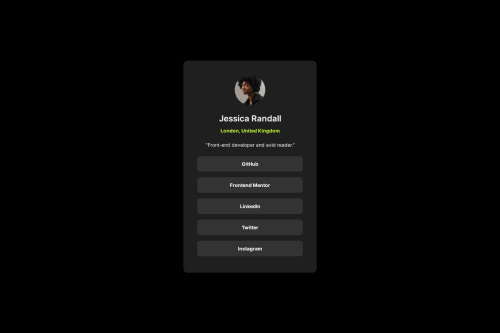Social links profile using html and vanilla

Solution retrospective
I am improving with my figma file use.
What challenges did you encounter, and how did you overcome them?getting the li and anchor tags to work together on a hover which I used the inherit value so that the text would also change on an li hover
What specific areas of your project would you like help with?not much on this one pretty straight forward for me
Please log in to post a comment
Log in with GitHubCommunity feedback
- @KirativeWD
Hi there!
Great job completing this project.
I noticed you mentioned that you initially had some difficulty getting the hover to work and I wanted to give you a tip from what I saw in your CSS. Currently, the
lihas the hover state. This can make it confusing for users (if this were an active page) because when thelichanges colors, you'd expect to be able to click anywhere for the link to work—but it doesn't work that way. And if a user were to tab to the links, the colors would not change. So what can be updated to improve user experience and make the hover state easier to apply?a { display: block; }Anchor tags have an initial display value of inline. This makes it so that its width is constricted to its content. When you change the value of display to block, the anchor tags will now behave as any regular block-level element and fill its parent's width and padding can be used to achieve the intended height. However, you will encounter a problem because you're using flex and setting defined heights/widths. This can easily be fixed by adjusting the CSS like so...
.social-links { width: 100%; } /* remove all li styles */.social-linksonly needswidth: 100%because it's a flex child. But why remove all styles from the li? They're all going to be applied to the anchor tag which is how we'll make applying hover styles much easier! I will show you what selector to use instead.li:not(:last-of-type) { // <-- Selects all li except the last in the list margin-bottom: 1rem; // <-- So we can get the space between each element } a { display: block; // <-- To allow block-level styling applications background: #333; color: white; padding-block: 1rem; border-radius: 8px; transition: all 200ms ease-in-out; // <-- Just for fancy transitioning } a:is(:hover, :focus-visible) { // <-- Applies styles when hovering and tabbing color: black; background-color: #c4f82a; }With the prior applications, you now have hoverable links that are clickable within the entire box and change color when hovered and tabbed to.
Marked as helpful
Join our Discord community
Join thousands of Frontend Mentor community members taking the challenges, sharing resources, helping each other, and chatting about all things front-end!
Join our Discord